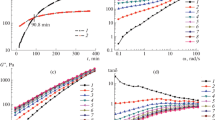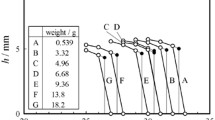Abstract
The rheological and thermal properties of mixed gels of gellan and agarose were studied by dynamic viscoelastic measurement and differential scanning calorimetry (DSC). E’ increased slightly up to a certain temperature To and then began to decrease with increasing temperature. This temperature To shifted to higher temperatures with increasing gellan content. The critical concentration for gelation Co becomes higher with increasing gellan content. Two endothermic peaks were observed in DSC curves for mixed gels. The higher temperature peak was attributed mainly to the melting of gellan gum network whilst the lower temperature peak was mainly attributed to the melting of agarose network. In the phase separated gels, gellan forms at first a network on cooling, and then agarose forms another network at lower temperatures.
Access this chapter
Tax calculation will be finalised at checkout
Purchases are for personal use only
Preview
Unable to display preview. Download preview PDF.
Similar content being viewed by others
References
G.R. Sanderson, Gellan gum, in: “Food Gel”s P.Harris Ed., Elsevier Applied Sci., London, pp. 201–232 (1990).
T. Matsuhashi, Agar, in: “Food Gel”s P.Harris Ed., Elsevier Sci., London, pp. 1–50 (1990).
D.A. Rees, E.R.Morris, D. Thorn & J. K. Madden, Shapes and interactions of carbohydrate chains, in: “The Polysaccharide”s G. 0. Aspinall Ed., Academic Press, New York, Vol. 1. pp. 195–290 (1982).
P. A. Williams and G.O. Phillips, Interactions in mixed polysaccharide systems, in: “Food Polysaccharide”s A.Stephens and I.C. M. Dea Eds., Marcel Dekker, in press.
M. Watase and K. Nishinari, Rheological and thermal properties of agarose and kappa-carrageenan gels containing urea, guanidine hydrochloride or formamide, Food Hydrocolloids, 1: 25 (1986).
K. Nishinari, S. Koide and K. Ogino, On the temperature dependence of elasticity of thermoreversible gels, J. Phys. (France), 46: 793 (1985).
A. H. Clark and S. B. Ross-Murphy, The concentration dependence of biopolymer gel modulus, Brit. Polymer J., 17: 164 (1985).
D. Oakenfull, A method for using measurements of shear modulus to estimate the size and thermodynamic stability of junction zones in noncovalently cross-linked gels, J. Food Sei., 49: 1103 (1984).
J. E. Eldridge and J.D.Ferry, Studies of the cross-linking process in gelatin gels. III. Dependence of melting point on concentration and molecular weight, J. Phys. Chem., 58:992(1954).
Author information
Authors and Affiliations
Editor information
Editors and Affiliations
Rights and permissions
Copyright information
© 1994 Springer Science+Business Media New York
About this chapter
Cite this chapter
Nishinari, K., Takaya, T., Watase, M. (1994). Rheology and DSC of Gellan-Agarose Mixed Gels. In: Nishinari, K., Doi, E. (eds) Food Hydrocolloids. Springer, Boston, MA. https://doi.org/10.1007/978-1-4615-2486-1_72
Download citation
DOI: https://doi.org/10.1007/978-1-4615-2486-1_72
Publisher Name: Springer, Boston, MA
Print ISBN: 978-1-4613-6059-9
Online ISBN: 978-1-4615-2486-1
eBook Packages: Springer Book Archive




